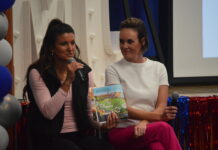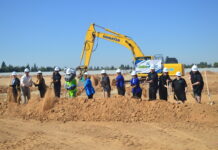
By Beth Eva | Contributed
Owner of Heartland Ranch
Hi again everyone! Beth Eva of Heartland Ranch Horse Training and Lessons here today with some tips and advice on keeping safe around your horse. Many people new to horses often have no idea how to remain safe around a horse, and many experienced individuals get comfortable and take chances they shouldn’t. I offer a Basic Ground Safety lesson program that helps people avoid common mistakes when handling their horse, and addresses many bad habits that I see regularly end in the horse or the owner becoming injured. Let’s discuss some simple ways of avoiding injury and some of the underlying principles that often lead to dangerous horse behavior.
There are some very basic rules to keeping safe around your horse, and these things should be made a habit by you. Let’s list some of these rules now.
Never assume a horse is safe or that you know how it will react. Always minimize risk by not taking chances where you could get hurt, even with the most gentle and well broke horses.
Always carefully supervise children around horses, even horses familiar to you that have been exposed to children. It’s not the horse’s responsibility to babysit the kids or keep them safe.
When catching your horse in a stall or pasture, never approach him if he turns his hind end towards you. Always approach from the side, even if you have to move him to get the correct position.
Don’t shove the halter on the horse’s face from the front. Instead, work from the side of his head and neck, and gently work the halter on with your hands on the sides of his neck and face or at his poll.
Never wrap the lead rope around your hand or arm, and be careful not to let the lead rope loop in a way that can catch and tighten on an appendage should the horse shy away from you.
When leading your horse, always keep him on a slightly slack lead, to the side and behind you at a safe distance. You don’t want constant pressure on the halter as that will make him numb and unresponsive, and you need enough distance so that if he spooks he won’t be jumping on top of you. It’s vital that he pay attention to you, respect your space and follow your lead.
Insure good halter fit. A too loose or too tight halter can spell disaster if he pulls away and creates pressure. A good quality rope halter, properly sized for your horse, is preferred. For the safety of your horse, never turn your horse loose with any halter on. There are too many ways for him to get injured with a halter on once he’s turned loose.
When tying your horse, always tie to a secure, immoveable object, never a moveable panel or fragile object, and use a quick release knot or panic snap so you can quickly release the horse if there’s a problem. Tie as high as is practical to avoid the horse getting a leg over the rope, and with about 18-24 inches of lead, as too short or too long can cause a hazard.
Tying to a trailer is often done, but is the source of frequent injuries to horses, so tie there as a matter of necessity only. If they paw or set back when trailer tied, there are often sharp edges where they can sustain injury.
Approach your tied horse from an angle where he can see you coming, and make some sort of verbal signal of your approach so he won’t be startled. Also, don’t pat him on the head from the front or squirt fly spray on his face and in his eyes. It’s an unpleasant experience that you’d react badly to, so don’t do it to your horse.
Never walk up directly behind any horse, as they can’t see you and could become frightened and panic, and it’s best to not approach from directly in front as that can cause them to feel overly pressured and seek escape.
Do not squat or kneel down next to your horse, as you might need to move away quickly if there’s a problem, so bend over to clean his hooves or inspect his legs, etc.
It’s highly suggested that you not hard tie your horse as he’s being saddled or bridled. Wrap the lead around the tie rail a couple times while saddling if you need him tied at all, and you should never bridle a hard tied horse. Don’t take the halter off his face and just tie it around his neck to keep him secure while bridling, as this is a common mistake I see very often end up in a wreck. Take the halter off and use the bridle reins around his neck to keep a hold on him while bridling to prevent his escape if need be.
Don’t saddle or bridle your horse while you’re crowded against the tie rail. Move your horse almost against and parallel to the tie rail so you have lots of room to work and escape if your horse sets back or shies away from something.
Do not get directly in front of your horse while he’s tied because you could become trapped and easily injured between him and the tie rail. If a hose pulls back when tied, many people move in front of the horse instinctively, but it’s a very dangerous place to be. When he sets back he’ll meet the resistance of the halter and usually lunge forward into the tie rail. That’s a bad place to be in that circumstance.
Do not cross under the neck or body of your horse. When going around the front of your horse, leave plenty of space for safety, and when going around the rear put your hand on his rump as you pass behind very closely so that if he was to kick the impact would be minimal, or pass at a distance far enough to avoid getting kicked at all.
It’s important to progressively tighten the cinch when saddling your horse, not just jerk it tight all at once. When bridling your horse work from the side as when haltering, use one hand on his poll to hold the top of the bridle as the other hand holds the bit to carefully feed it into the horse’s mouth, being sure to avoid banging it on his teeth. Many safety problems I see are from horses that react badly when being saddled or bridled, so extra time spent being patient here will pay off with a happier and safer horse.
Feed cookies, carrots and other treats from a bucket on the ground, not directly from your hand. A spoiled and greedy horse will often bite a finger on accident.
Do not let your horse crowd your personal space. It’s a sign of disrespect and can be very unsafe. You want your horse to treat you as the Alpha, which means he needs to avoid being in your space unless specifically invited by you. A careless horse that’s not paying attention to you can be just as dangerous as a horse that purposely kicks or bites.
While these are some basic rules to help keep you safe around your horse, the two main principles involved in everything here are: one, take personal responsibility for your safety around a horse and two, make sure your animal respects you and your space. People often trust their horses too much. They are living, breathing animals that have good and bad days, and can become frightened and reactive without notice. There is no such thing as a bomb-proof horse, and all horses should be treated with the respect that a 1,200-pound animal deserves. They are not puppies, and can do huge damage to a human with minimal effort. The horse needs to respect you as a leader and listen to your commands as well as respect your space. Practice these skills each and every time you are with your horse, and you’ll be rewarded with a much more pleasant and safe experience with him.
As always, if you feel you need more information on what we’ve discussed here today, or would like to enroll yourself or your family member in my Basic Ground Safety lesson program, please feel free to contact me. Until then then I wish you all a Blessed day!
Beth Eva, Owner/Trainer
Heartland Ranch Horse Training and Lessons
Phone: (559) 281-0782
Email: 1betheva1@att.net
Facebook: @HeartlandRanchTraining
James Light contributed to this article








